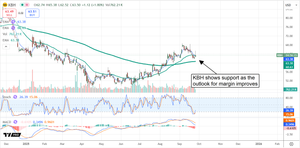
Financial markets are currently navigating a complex and divergent commodity landscape as of September 24, 2025. After an extended period of robust gains, both gold and silver futures have begun to retreat from their recent record highs, signaling a potential wave of profit-taking and a cautious recalibration by investors. Simultaneously, crude oil prices have surged, reaching seven-week highs amid tightening supplies and escalating geopolitical tensions.
This mixed trend carries significant immediate implications for global financial markets. The rise in crude oil prices threatens to reignite inflationary pressures across economies, impacting everything from transportation costs to manufacturing inputs. Conversely, the pullback in precious metals, while potentially temporary, suggests a nuanced shift in investor sentiment, even as underlying safe-haven demand persists amidst ongoing uncertainties. Investors are now keenly watching how central banks, particularly the U.S. Federal Reserve, will respond to these contradictory signals in their pursuit of economic stability.
Detailed Coverage: A Tale of Two Commodity Markets
The recent movements in commodity markets present a stark contrast between precious metals and energy. Gold futures for December delivery, after hitting an all-time high of approximately $3,791.11 per ounce on September 23, 2025, experienced a modest dip, trading around $3,799.07 per ounce on September 24. This retreat of 0.44% was mirrored by silver December futures, which fell by a similar margin to $44.41 per ounce, despite having recently tested 14-year highs. This minor correction is largely attributed to traders cashing in on substantial gains accumulated over the past year and a half.
Adding to the downward pressure on precious metals were remarks from US Federal Reserve Chair Jerome Powell, who emphasized the "no risk-free path" for monetary policy and cautioned against premature interest rate cuts. This hawkish stance contributed to a modest strengthening of the US dollar, making dollar-denominated gold and silver more expensive for international buyers and consequently dampening demand. Despite this short-term profit-taking, the broader bullish sentiment for gold and silver remains underpinned by persistent global inflation concerns, ongoing geopolitical instability, and sustained central bank gold acquisitions. Silver, in particular, has demonstrated notable outperformance year-to-date, benefiting from its dual role as a safe-haven asset and a critical industrial metal, with robust demand from burgeoning sectors like solar panels and electric vehicles.
In stark contrast, crude oil prices have experienced a significant surge, climbing about 3% to a seven-week high on September 24, 2025. Brent crude futures rose to $69.31 a barrel, while U.S. West Texas Intermediate (WTI) crude futures settled at $64.99 a barrel. This upward trajectory is primarily driven by a surprise drawdown in U.S. weekly crude inventories, which saw a decrease of 607,000 barrels last week, according to the Energy Information Administration (EIA).
Compounding the supply concerns are ongoing geopolitical issues. Stalled negotiations to restart oil exports from Iraq's Kurdistan region have kept approximately 230,000 barrels per day off the market since March 2023. Furthermore, escalating tensions, including NATO's firm response to Russian airspace incursions and Ukrainian drone strikes targeting Russian refineries and pipelines, have amplified worries about global supply disruptions. Comments from former U.S. President Donald Trump urging European countries to reduce their energy purchases from Russia, alongside Russia's consideration of restrictions on diesel exports, have further fueled market anxiety and pushed oil prices higher.
Corporate Fortunes Diverge Amidst Commodity Swings
The current commodity market dynamics are creating a distinct bifurcation in corporate fortunes, with energy sector players poised for significant gains while precious metals miners face headwinds. Companies heavily invested in oil and gas exploration, production, and services are set to benefit directly from the surge in crude oil prices, translating into increased revenues and profitability. Conversely, the retreat in gold and silver prices will likely compress margins for precious metals mining companies, though industrial demand for silver could offer a mitigating factor for some.
Winners in the Energy Sector: Exploration & Production (E&P) companies and oilfield services providers are the clear beneficiaries of rising crude oil prices. Higher oil prices incentivize increased capital expenditure in drilling and production activities, directly boosting demand for services and equipment. Major E&P players such as Exxon Mobil Corporation (NYSE: XOM), Chevron Corporation (NYSE: CVX), and ConocoPhillips (NYSE: COP) are expected to see enhanced profitability from their oil and gas sales. Similarly, independent producers like Devon Energy Corporation (NYSE: DVN) and Diamondback Energy, Inc. (NASDAQ: FANG) are well-positioned to capitalize on the higher price environment.
The ripple effect extends to oilfield services companies, which provide the crucial infrastructure and expertise for extraction. Firms like Schlumberger Limited (NYSE: SLB), Halliburton Company (NYSE: HAL), and Baker Hughes Company (NASDAQ: BKR) will likely experience increased demand for their drilling, completion, and production services. This surge in activity could lead to higher utilization rates, improved pricing power, and ultimately, stronger financial performance for these key industry players.
Challenges for Precious Metals Miners: On the other side of the spectrum, gold and silver mining companies are facing a more challenging environment due to the retreat in precious metal prices. A decline in the per-ounce value of gold and silver directly impacts their top-line revenue and, given relatively fixed extraction costs, can significantly squeeze profit margins. Major gold producers like Newmont Corporation (NYSE: NEM), Barrick Gold Corporation (NYSE: GOLD), and Agnico Eagle Mines Limited (NYSE: AEM) will need to manage costs meticulously to maintain profitability.
Silver miners, including Pan American Silver Corp. (NASDAQ: PAAS), First Majestic Silver Corp. (NYSE: AG), and Hecla Mining Company (NYSE: HL), are also vulnerable to price declines. However, silver's robust industrial demand, particularly from sectors like solar panels and electric vehicles, could provide a floor for prices and partially offset the impact of reduced investment demand. Companies with significant exposure to industrial silver production may find some resilience compared to those solely focused on its monetary appeal. Precious metals streaming and royalty companies such as Wheaton Precious Metals Corp. (NYSE: WPM) and Franco-Nevada Corporation (NYSE: FNV), while having more stable margins due to their business model, will still see their overall asset values and future revenue streams influenced by sustained price movements.
Wider Significance: Geopolitical Undercurrents and Inflationary Tides
The current commodity market divergence is more than just a fleeting price fluctuation; it reflects deeply entrenched geopolitical tensions, persistent inflationary pressures, and evolving industrial demands that have broader implications for the global economy. The surge in crude oil prices, fueled by supply disruptions and geopolitical instability, fits into a broader trend of energy market volatility that has been a defining characteristic of the 2020s. The stalled Iraq-Kurdistan oil exports since March 2023, coupled with ongoing hostilities in Eastern Europe and the Middle East, underscore the fragility of global energy supply chains. These events highlight the increasing weaponization of energy resources and the vulnerability of nations reliant on imported oil.
This upward pressure on energy costs has significant ripple effects across various industries. Transportation companies, from airlines like Delta Air Lines, Inc. (NYSE: DAL) to logistics giants such as United Parcel Service, Inc. (NYSE: UPS), face increased operational expenses, which they may pass on to consumers, further stoking inflation. Manufacturing sectors, heavily reliant on energy for production, will also see their input costs rise, potentially impacting their competitiveness and profit margins. For consumers, this translates to higher prices at the pump and for a wide array of goods and services, eroding purchasing power and potentially slowing economic growth.
Historically, periods of surging oil prices have often preceded broader economic slowdowns or recessions, as seen in the 1970s oil crises and the run-up to the 2008 financial crisis. While the current context is different, the inflationary impulse from energy costs poses a significant dilemma for central banks worldwide. Regulatory bodies and governments might face renewed pressure to address energy security, potentially accelerating investments in alternative energy sources or exploring strategic petroleum reserve releases to stabilize markets. The European Union, having grappled with energy dependency on Russia, continues to seek diversification, and the current oil surge reinforces the urgency of these efforts.
Conversely, the retreat in gold and silver from record highs, while partly due to profit-taking, also reflects the nuanced dance between safe-haven demand and the perceived strength of traditional financial assets. In periods of heightened uncertainty, precious metals typically shine. Their recent dip amidst a strengthening US dollar and cautious Fed remarks suggests that some investors might be rotating into other assets or simply taking profits. However, the sustained central bank gold hoarding and the underlying geopolitical risks indicate that the long-term bullish case for precious metals as a hedge against inflation and instability remains largely intact. The increased industrial demand for silver, particularly from the burgeoning green energy sector, also provides a structural tailwind that differentiates its market dynamics from pure monetary metals.
What Comes Next: Navigating Volatility and Strategic Shifts
The immediate future for commodity markets promises continued volatility, driven by a complex interplay of geopolitical developments, central bank policies, and the accelerating global energy transition. For investors, understanding these diverging trends and adapting strategies will be paramount. While crude oil is currently surging, expert forecasts suggest this may be a short-term phenomenon, with precious metals poised for continued long-term growth despite recent pullbacks.
In the short term (Q4 2025 - early 2026), the trajectory for crude oil appears poised for a reversal. Despite the current surge, many analysts predict a significant price decline, with Brent crude potentially falling to around $59/barrel in Q4 2025 and further to $50/barrel in early 2026. This anticipated downturn is largely attributed to expected increases in global oil supply from OPEC+ members and non-OPEC countries, which could outpace demand growth and lead to inventory builds. For energy investors, this suggests a need for caution and a focus on short-term trading opportunities driven by geopolitical headlines, rather than sustained long positions. Strategic pivots may include monitoring OPEC+ decisions closely and potentially shifting focus to natural gas, where drilling activity is expected to concentrate.
For precious metals, despite the recent retreat, the long-term outlook remains largely bullish. Gold, having reached record highs, is projected to average around $4,296-$4,350 by the end of 2025 and could potentially reach $5,155 by 2030, with some aggressive forecasts even nearing $8,900. Silver is also expected to continue its upward trajectory, with targets of $40-$52 per ounce by year-end 2025 and potential levels of $75-$90 by 2030. This sustained optimism is driven by persistent safe-haven demand amidst global uncertainties, continued central bank gold purchases, and robust industrial demand for silver in green technologies. Investors in precious metals may consider diversification, with gold for wealth preservation and silver for growth potential, and utilize various access methods from physical metals to ETFs and mining stocks.
Potential scenarios for the coming months include a continued period of geopolitical volatility and inflationary pressures, which would be bullish for precious metals and create extreme volatility for energy. Alternatively, a global economic slowdown coupled with increased oil supply could lead to a significant decline in crude oil prices, while precious metals might still find support from safe-haven demand. An accelerated energy transition would pose a long-term headwind for oil demand but create opportunities for critical metals like silver. Investors should be prepared for these diverse outcomes, employing robust risk management strategies and consistently rebalancing portfolios to align with their long-term objectives and risk tolerance.
Comprehensive Wrap-up: Navigating a Shifting Commodity Landscape
The financial markets are currently experiencing a significant recalibration in the commodity sector, marked by a retreat in gold and silver futures from record highs and a concurrent surge in crude oil prices. This divergence, observed as of September 24, 2025, underscores the complex interplay of geopolitical tensions, macroeconomic policies, and evolving supply-demand dynamics shaping global financial landscapes. While the immediate implications include heightened inflationary pressures from rising oil, and a monetary policy dilemma for central banks, the long-term outlook for these commodities presents a nuanced picture requiring careful investor consideration.
The key takeaways from this event are the clear bifurcation of fortunes for commodity-linked companies – energy producers and service providers are poised for gains, while precious metals miners face margin compression. Furthermore, the persistent demand for gold and silver as safe-haven assets, coupled with silver's growing industrial applications, suggests underlying resilience despite short-term profit-taking. For crude oil, the current surge, driven by inventory drawdowns and supply concerns, is countered by expert forecasts predicting a potential decline in the short to medium term due to anticipated oversupply.
Moving forward, the market will remain highly sensitive to geopolitical developments, particularly those affecting energy supply chains and global trade. Central bank actions, especially regarding interest rates and inflation management, will also play a pivotal role in determining the attractiveness of both precious metals and energy assets. Investors should watch for further signals on production quotas from OPEC+, inventory reports from major economies, and any shifts in the global energy transition narrative.
In conclusion, while the immediate headlines point to a retreat in precious metals and a surge in oil, a deeper analysis reveals a dynamic and potentially contradictory future. Prudent investors will need to maintain a diversified portfolio, stay agile in their strategic pivots, and diligently monitor the macroeconomic and geopolitical currents that continue to reshape the commodity markets. This content is intended for informational purposes only and is not financial advice.





